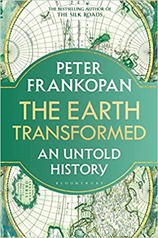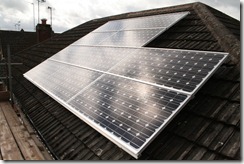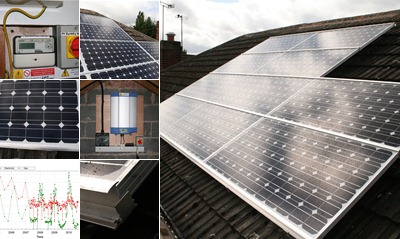 It is rare that I am menaced by the sheer size of a book but The Earth Transformed by Peter Frankopan has done this to a degree. The Silk Roads, by the same author is similarly massive. So in a break from my usual habit I am going to review as I read.
It is rare that I am menaced by the sheer size of a book but The Earth Transformed by Peter Frankopan has done this to a degree. The Silk Roads, by the same author is similarly massive. So in a break from my usual habit I am going to review as I read.
The book is about the interplay of climate and humanity, and how humanity impacts the environment with an attempt to cover history across the world rather than focussing on Western Europe.
The extensive footnotes for this book are found in a separate downloadable pdf.
0 – Introduction – Frankopan is a year younger than me – born in 1971, and his early memories were shaped by news reports of acid rain, the fear of nuclear winter and Chernobyl – all stark demonstrations of man’s potential impact on the environment.
1 – The World from the Dawn of Time(4.5bn-7m BC) – The earth’s environment has always been changing, in deep time there was a much lower concentration of oxygen in the atmosphere. Those animals we see around us are the result of evolution through multiple cataclysmic environmental events.
2 – On the origins of our species (7m BC-12,000BC) – Climate change in central Africa and growing social groups led to speciation of the hominid group. We started large scale manipulation of the environment – managing forests with fire – 65,000 years ago.
3 – Human interactions with Ecologies (c.12000-c.3500BC) – End of the Younger Dryas and the start of the Holocene is a key point for civilisations, the climate becomes more benign and stable and larger settlements start to grow.
4 – The first cities and trade networks (c3500-c2500 BC) – the first cities are founded, and arguably the first anthropogenic climate change takes place. With cities came hierarchies, ownership and vulnerability to shocks and disease.
5 – On the risks of living beyond one’s means (2500BC-c.2200BC) – One such shock is the great drought of 2200BC, often seen as a global phenomena but actually rather complicated with different regional effects and an impact which was perhaps most obvious on the ruling class.
6 – The first age of connectivity (c.2200-c.800BC) – the environment provides resources unevenly, and so trade is necessary as societies become more sophisticated, these trade networks lead to interdependence so when one society falls others are impacted. The trade is not just in goods but also in ideas.
7 – Regarding Nature and the Divine (c1700-c.300BC) – Religions which we still see today arose several hundred years BC, and many of them made references to the environment. The ruler was often an intermediary to the gods/control of the weather – rain being particularly important. Even in this time there were exhortations to preserve the environment.
8 – The Steppe Frontier and Formation of Empires (c.1700-c.300BC) – the Eurasian steppes provided a catalyst for the growth of empires in the neighbouring region, alongside the domestication of the horse in about 3000BC. This combination provided rapid transport, and the flatness of the terrain made expansion easy. There is also an interplay between nomadic and pastoral peoples.
9 – The Roman Warm Period (c.300BC-AD c.500) – the Roman Empire grew at a time of benign and stable climatic conditions – and fell when those climatic conditions changed. Contemporary writers noted the pollution in Rome and other big cities. We can see the lead of the Roman Empire in Greenland ice cores.
10 – The Crisis of Late Antiquity (AD c.500-c.600) – the decades from 530AD saw multiple volcanic eruptions leading to global cooling, food shortages, and the rise of disease (the Justinian plague) and the fall of empires.
11 – The Golden Age of Empire (c.600-c.900) – the Prophet Mohammad’s agreement with the ruling elite in Mecca in 628AD provided an Arab identity that grew to an Empire stretching across North Africa and into Spain. Trade grows with sub-Saharan Africa. These patterns are replicated in the Americas and the Far East. Literacy grew in the eighth century with the introduction of paper from China. Empires started to decline in the 9th century as another warmer drier period started.
12 – The Medieval Warm Period (c.900-c.1250) – the Medieval Warm Period was both warm, and stable with unusually low levels of volcanic activity. During this time there was a large growth in global population, and Northern Europe saw significant growth. This growth was a result of improvements in crops and technology, as well as the benign climate.
13 – Disease and the formation of a New World (c.1250-c.1450) – the 13th century saw the rise of the Mongol empire, under Genghis Khan, stimulated by wetting weather in the steppe leading to more productive pasture when other areas were suffering drought. But the wet weather and the extensive trade networks of the Empire led to the rise of Black Death. Interesting parallels between post-Plague and post-1918 influenza Europe – the roaring twenties.
14 – On the expansion of Ecological Horizons (c.1400-c.1500) – the 14th and 15th century saw the fall of some of those empires that rose during the earlier more benign and stable weather, more driven by the instability of large empires than by climate change. It also saw the European "exploration" of the world and the large scale transport of plant and animal species across the world.
15 – The Fusion of the Old and the New Worlds (c.1500-c.1700) – the European "discovery" of the New World introduced a massive migration of flora and fauna around the world, potatoes, tomatoes,chillies from the New World to the Old. Pigs, sheep, goats and cattle from the Old to the New.
16 – On the exploitation of Nature and People (c.1650-c.1750) – the new sugar, tobacco and cotton industries required a large workforce, resistant to malaria, and Africans fitted the bill – this chapter to about slavery.
17 – The Little Ice Age (c.1550-c.1800) – the Little Ice Age has long been known but its magnitude was quite variable around the world, many things have been ascribed to the Little Ice Age but connections and causality are tenuous. The 17th century saw significant developments in military technology and spending on professional armies in Europe. There was also a large rise in urbanisation. Variable weather, uncertain crops hit some countries hard.
18 – Concerning Great and Little Divergences (c.1600-c.1800) – 1600-1800 was the period in which the economies of Europe diverged from those of Asia and Africa, and in Europe the North pulled away from the South. The introduction of the potato to Europe was important, as was maize and manioc (cassava) to Africa.
19 – Industry, extraction and the Natural World (c.1800-c.1870) – markets became truly global with wheat from North America cheaper to ship from Canada to Liverpool than from Dublin to Liverpool. Colonialism was at its height with Britain leading the world and the Americans expelling indigenous people from their own lands.
20 – The Age of Turbulence (c.1870-c.1920) – new resources became ripe for exploitation like rubber, guano and tin. Industrialisation proceeded apace. Concerns about climate began, and the Carrington Event and the Krakatoa eruption started scientists thinking about global impacts. Global pandemics made an appearance for both people and animals.
21 – Fashioning New Utopias (c.1920-c.1950) – the middle years of the 20th century saw a new wave of exploitation with oil, copper, uranium and more recently lithium becoming important resources. Colonialism receded but was replaced by corporate and government interference in states. In the Soviet Union ecological damage, and great human upheaval was driven by the dash to modernise but in a communist rather than capitalist framework.
22 – Reshaping the Global Environment (the mid-Twentieth Century) – the USSR and the USA started large scale environmental modification projects, see Teller’s proposals to use nuclear explosions to change just about anything.
23 – The Sharpening of Anxieties (c.1960-c.1990) – in the sixties the USA and USSR got heavily into weather modification, and the Americans into Agent Orange in Vietnam. The USA programme was conducted in deep secrecy, and when it was revealed there was an outcry which lead to a treaty banning such environmental modification. This led to a wider thaw of Cold War interactions.
24 – On the edge of Ecological Limits (c.1990-today) – the 1990s saw the fall of the Soviet Union and the rise of Industrial China. It also saw the discussions over climate change heating up.
25 – Conclusions – Frankopan’s conclusion is rather gloomy, he highlights how we are failing to act on climate change but then points we may suffer worse consequences from volcanic activity, or an asteroid strike!
There are themes across the whole book, in the environment we see periods of stable climate interspersed by periods of change – particularly driven by volcanic eruptions. From the human side we see the growing scale of civilisations, larger civilisations with more connections are more vulnerable to instability and the fall of other civilisations. We see ever increasing urbanisation and exploitation of the environment at ever greater scale.
Although initially intimidating, I found The Earth Transformed rather readable – perhaps because I saw each chapter as a separate essay.



